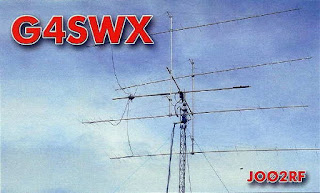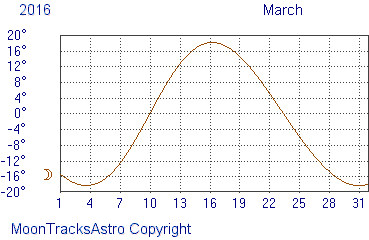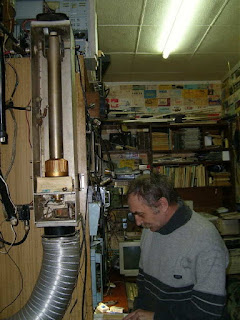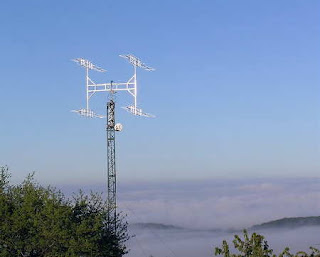Posts Tagged ‘JT65B’
 April Moonbounce
April Moonbounce
 |
| My Moonrise |
This week I had several days of unobstructed ocean moonrises as the Moon peaked on its monthly northern declination track. Thanks to the recent topping of my next door neighbour's large Douglas Fir, and removal of low-hanging branches, I am now able to track moonrises a little further to the south than before and can add two more EME days that were previously blocked by the large tree. All operations are on 2m JT65B mode, using a 9el Yagi and 140W output.
When I started (April 1) conditions looked as if they should be good, with lunar perigee (Moon's closest approach), degradation (background skynoise) and declination all looking favorable, but I was in for a surprise.
The rising yellow plot indicates the Earth-Moon distance growing further apart (increasing path losses) while the red plot indicates fluctuation in daily skynoise (temperature) near the moon. The blue plot indicates declination track from north to south ... for me, the higher the better.
 |
| courtesy: http://www.mmmonvhf.de/eme.php |
On day three, five new 'initials' were worked including one new state (New York) and two new DXCC countries! Truly surprising was that two of the stations worked were using just two Yagis, with both stations answering one of my 'CQ's.
Good conditions continued for the next few days, bringing my initials count from #87 to # 95, with the following stations all going into the log, turning a disappointing start into one of the best lunar sessions I have encountered:
HA6NQ, LZ2FO (two 13 el Yagis), EB5EEO, K2ZJ (two 14 el Yagis), DK5YA, S52LM, F8DO, PA5Y, SV6KRW, UA3PTW, OK1UGA.
April's operation brought my 2m DXCC count to 29 and states worked total to 27.
| SV6KRW's 4 x 8el Array |
| EB5EEO's 4 x 32el Cross-polarized Array (16V / 16H) |
 |
| DK5YA's 4 x 22 Cross-polarized Array (11V / 11H) |
 April Moonbounce
April Moonbounce
 |
| My Moonrise |
This week I had several days of unobstructed ocean moonrises as the Moon peaked on its monthly northern declination track. Thanks to the recent topping of my next door neighbour's large Douglas Fir, and removal of low-hanging branches, I am now able to track moonrises a little further to the south than before and can add two more EME days that were previously blocked by the large tree. All operations are on 2m JT65B mode, using a 9el Yagi and 140W output.
When I started (April 1) conditions looked as if they should be good, with lunar perigee (Moon's closest approach), degradation (background skynoise) and declination all looking favorable, but I was in for a surprise.
The rising yellow plot indicates the Earth-Moon distance growing further apart (increasing path losses) while the red plot indicates fluctuation in daily skynoise (temperature) near the moon. The blue plot indicates declination track from north to south ... for me, the higher the better.
 |
| courtesy: http://www.mmmonvhf.de/eme.php |
On day three, five new 'initials' were worked including one new state (New York) and two new DXCC countries! Truly surprising was that two of the stations worked were using just two Yagis, with both stations answering one of my 'CQ's.
Good conditions continued for the next few days, bringing my initials count from #87 to # 95, with the following stations all going into the log, turning a disappointing start into one of the best lunar sessions I have encountered:
HA6NQ, LZ2FO (two 13 el Yagis), EB5EEO, K2ZJ (two 14 el Yagis), DK5YA, S52LM, F8DO, PA5Y, SV6KRW, UA3PTW, OK1UGA.
April's operation brought my 2m DXCC count to 29 and states worked total to 27.
| SV6KRW's 4 x 8el Array |
| EB5EEO's 4 x 32el Cross-polarized Array (16V / 16H) |
 |
| DK5YA's 4 x 22 Cross-polarized Array (11V / 11H) |
 Thursday’s Moonrise
Thursday’s Moonrise

I couldn't hold out any longer! The sight of a full-moon rising over the ocean a few nights ago was just too difficult to resist ... I would have to spark-up my 2m mini moonbounce system and see what was happening.
The QSLs are now all in from my last eme adventures in the early summer, bringing my total number of contacts to 80.
 |
| RW1AY used an 8 x 15el cross-polarized array |
 |
| EA4CQ's 4 x 9el DK4ZB yagis |
 |
| YU7AA's 8 x 13el nested array |
 |
| NC2V used a 4 x 20el cross-polarized array |
 |
| VE1KG's 4 x 17el yagi array |
 |
| DK5SO used four 20' long yagis and 750W |
My simple system uses a single 9el m2 yagi and an old third-hand 140W brick amplifier and built-in GaAsFET preamp. The yagi is mounted atop my 50' tower and fed with about 100' of RG-213 cable, along with its 2+ db of loss.
Looking directly out over the saltwater of Georgia Strait seems to provide the near theoretical 'sea-gain' of 6db, making the little yagi behave more like a box of four in terms of gain. As well, there are no noise sources when pointing out over the water at the rising moon. Not being able to elevate the antenna means 'moonrises' only, and usually gives me about 90 minutes per session before the moon gets too high.
Last night was surprisingly active, mostly with U.S. stations, as it was still early evening here but there were also several early-rising Europeans on the band.
One outstanding signal was from a station I had not worked before, OK1DIG, who was running a 4 x 15 element yagi array. I called him a few times when his signal was easily audible (-15db) but he seemed to only hear me later, replying to one of my 'CQ's, with his signal starting to drop here. This is often the case on 2m eme as a reciprocal two-way path is not always the rule. He was my only contact of the evening (#81) but also heard were K9SLQ, UT3MD, PA3FYC, all of whom I have yet to work.
 |
| OK1DIG's audible JT65B CQs |
 Thursday’s Moonrise
Thursday’s Moonrise

I couldn't hold out any longer! The sight of a full-moon rising over the ocean a few nights ago was just too difficult to resist ... I would have to spark-up my 2m mini moonbounce system and see what was happening.
The QSLs are now all in from my last eme adventures in the early summer, bringing my total number of contacts to 80.
 |
| RW1AY used an 8 x 15el cross-polarized array |
 |
| EA4CQ's 4 x 9el DK4ZB yagis |
 |
| YU7AA's 8 x 13el nested array |
 |
| NC2V used a 4 x 20el cross-polarized array |
 |
| VE1KG's 4 x 17el yagi array |
 |
| DK5SO used four 20' long yagis and 750W |
My simple system uses a single 9el m2 yagi and an old third-hand 140W brick amplifier and built-in GaAsFET preamp. The yagi is mounted atop my 50' tower and fed with about 100' of RG-213 cable, along with its 2+ db of loss.
Looking directly out over the saltwater of Georgia Strait seems to provide the near theoretical 'sea-gain' of 6db, making the little yagi behave more like a box of four in terms of gain. As well, there are no noise sources when pointing out over the water at the rising moon. Not being able to elevate the antenna means 'moonrises' only, and usually gives me about 90 minutes per session before the moon gets too high.
Last night was surprisingly active, mostly with U.S. stations, as it was still early evening here but there were also several early-rising Europeans on the band.
One outstanding signal was from a station I had not worked before, OK1DIG, who was running a 4 x 15 element yagi array. I called him a few times when his signal was easily audible (-15db) but he seemed to only hear me later, replying to one of my 'CQ's, with his signal starting to drop here. This is often the case on 2m eme as a reciprocal two-way path is not always the rule. He was my only contact of the evening (#81) but also heard were K9SLQ, UT3MD, PA3FYC, all of whom I have yet to work.
 |
| OK1DIG's audible JT65B CQs |
 April’s Single-Yagi EME
April’s Single-Yagi EME
With several QSL's from last month's EME action now arriving, April's 'best days' have just concluded. For me, operating with no antenna elevation, 'best days' mean those with northern-most lunar declinations (these put the moon rising clearly and almost directly out in front of the house, not in the neighbour's trees); not having the moon near the sun and also, having the moon closer to perigee (closest approach to earth) rather than apogee (furthest from earth). With just a single 9 element yagi, every db is precious.
A website that helps determine when these good days occur, is the Making More Miles On VHF eme page. A graphical display of several important elements will easily determine which days might be best to operate ...
... but I have also found success on days that don't look particularly great, with the moon approaching apogee and it's subsequent higher db path loss. As with most radio propagation, there is also some magic involved and, just like on any band, some days are simply 'better' and for no obvious reason.
This month saw six EME contacts, some with stations worked previously, in 2007, and not 'new uniques', while three were new, bringing my uniques total to 73, with this small, horizon-gain assisted system.
G4SXW John 4 x 16el array #71 ... answered my CQ
KB8RQ Gary 24 X 13el array!! worked with moon at 1 deg high
UX5UL Oleg 4 x 16el array #72
UT6UG Val 4 x 32el array #73 Val and Oleg both live in Kyiv, Ukraine
RK3FG Anatoly 4 X 15el array
K9MRI Joe 8 X 28el array - Indiana
As summer approaches, it will be interesting to see how favorable the above mentioned variables will come into play as many of the best northerly declination days will also closely follow the sun and its increased background skynoise ... not so much a problem for me but for those bigger stations trying to hear a very weak signal in a noisier sky.
A website that helps determine when these good days occur, is the Making More Miles On VHF eme page. A graphical display of several important elements will easily determine which days might be best to operate ...
 |
| courtesy: http://www.mmmonvhf.de/eme.php |
This month saw six EME contacts, some with stations worked previously, in 2007, and not 'new uniques', while three were new, bringing my uniques total to 73, with this small, horizon-gain assisted system.
G4SXW John 4 x 16el array #71 ... answered my CQ
KB8RQ Gary 24 X 13el array!! worked with moon at 1 deg high
UX5UL Oleg 4 x 16el array #72
UT6UG Val 4 x 32el array #73 Val and Oleg both live in Kyiv, Ukraine
RK3FG Anatoly 4 X 15el array
K9MRI Joe 8 X 28el array - Indiana
 |
| G4SWX 4 x 16 el EME Array |
 |
| KB8RQ 24 x 13 el EME Array |
As summer approaches, it will be interesting to see how favorable the above mentioned variables will come into play as many of the best northerly declination days will also closely follow the sun and its increased background skynoise ... not so much a problem for me but for those bigger stations trying to hear a very weak signal in a noisier sky.
 March’s QRP EME Window
March’s QRP EME Window
This past week provided the month's best moonrises for my location, when the moon's position traversed its most northerly declinations. The afternoon moonrises directly in front of the house and over the ocean, provided about 90 minutes of 'moontime' for several days in a row.
My minimal system (single 9el Yagi and 140w) makes it very easy to see the day to day changes in EME conditions due to various causes such as local geomagnetic conditions, Faraday rotation and libration fading ... or combinations of each! One of the days was particularly good, with numerous signals heard throughout the session while the next day was just the opposite, with only a few very weak signals and no contacts. On that particular day, I was being heard well by several European stations but was unable to hear any of them ... a true 'one-way' path and not uncommon on EME.
Several smaller 4-Yagi stations were worked during the week, re-enforcing the benefits of having a moonrise over the ocean. As mentioned previously, the extra 6db of horizon gain allows my single 9el Yagi to perform more like a stack of four 9el Yagis. One of the fellows that I worked, DK5EW in Germany, asked if there was anything 'special' about my location that would make my very small station sound so strong at his end ... the ocean is clearly doing its job!
Altogether, 12 new stations were worked during March's window, bringing my total to 70 "initials". From the looks of the amount of activity, there are still many stations yet to work, that should be within range of my system.
Stations worked this week were:
I2FAK, UA3PTW, RZ3BA/1, SK5AA, PA2CHR, ES3RF, YO3JR, PA5Y, DK5EW, SM7GVF, EA4CYQ and W5ZN.
Three of these stations were using relatively compact antenna systems, consisting of 4x8el or 4x9el arrays, while the rest were larger. I have yet to tally up my DXCC or states total on 2m, but I know that W5ZN, in Arkansas, was a new state.
Up until this past week, the highest moon elevation that I have completed a QSO was with the moon at 18 degrees above the horizon. This week it was extended, at what is probably the limit of my fixed antenna, to 19.6 degrees when working ES3RF. At the other end of the scale, IK2FAK was worked with the moon at only .87 degrees high!
This month also provided my first glimpse of a 2m DX 'pileup', when J8/WW2DX in the Grenadine Islands showed up, calling CQ via the moon. My screen shot below shows at least 12 different stations calling him during his one-minute listening period ... some not yet 'warmed-up' as seen by their drifting oscillators.With several of the signals audible, it was an amazing thing to observe.
All in all, March's short sessions were very rewarding but as summer approaches, more of my well-placed moonrises will also be very close to the Sun and it's associated higher noise levels ... probably something my little system will not be able to handle so well.
 |
| Lunar declination track for March courtesy: http://www.moontracks.com/moon-declinations.html |
My minimal system (single 9el Yagi and 140w) makes it very easy to see the day to day changes in EME conditions due to various causes such as local geomagnetic conditions, Faraday rotation and libration fading ... or combinations of each! One of the days was particularly good, with numerous signals heard throughout the session while the next day was just the opposite, with only a few very weak signals and no contacts. On that particular day, I was being heard well by several European stations but was unable to hear any of them ... a true 'one-way' path and not uncommon on EME.
 |
| My small EME station. Note old microwave oven blower on the 'brick' amplifier. |
Several smaller 4-Yagi stations were worked during the week, re-enforcing the benefits of having a moonrise over the ocean. As mentioned previously, the extra 6db of horizon gain allows my single 9el Yagi to perform more like a stack of four 9el Yagis. One of the fellows that I worked, DK5EW in Germany, asked if there was anything 'special' about my location that would make my very small station sound so strong at his end ... the ocean is clearly doing its job!
Altogether, 12 new stations were worked during March's window, bringing my total to 70 "initials". From the looks of the amount of activity, there are still many stations yet to work, that should be within range of my system.
Stations worked this week were:
I2FAK, UA3PTW, RZ3BA/1, SK5AA, PA2CHR, ES3RF, YO3JR, PA5Y, DK5EW, SM7GVF, EA4CYQ and W5ZN.
Three of these stations were using relatively compact antenna systems, consisting of 4x8el or 4x9el arrays, while the rest were larger. I have yet to tally up my DXCC or states total on 2m, but I know that W5ZN, in Arkansas, was a new state.
Up until this past week, the highest moon elevation that I have completed a QSO was with the moon at 18 degrees above the horizon. This week it was extended, at what is probably the limit of my fixed antenna, to 19.6 degrees when working ES3RF. At the other end of the scale, IK2FAK was worked with the moon at only .87 degrees high!
This month also provided my first glimpse of a 2m DX 'pileup', when J8/WW2DX in the Grenadine Islands showed up, calling CQ via the moon. My screen shot below shows at least 12 different stations calling him during his one-minute listening period ... some not yet 'warmed-up' as seen by their drifting oscillators.With several of the signals audible, it was an amazing thing to observe.
 |
| 2m pile up on J8/WW2DX |
 |
| The 4 x 8 el cross-polarized array of PA5Y |
 |
| YO8JR sending his 'RR' followed by '73' |
 Single Yagi Moonbounce
Single Yagi Moonbounce
 |
| courtesy: JPL/NASA |
In early 2007, I decided to try 2m moonbounce using WSJT's JT65B digital mode. Over the years, moonbounce has gradually drifted away from CW to the much less demanding weak signal digital mode, allowing smaller stations to still explore the excitement of exchanging signals via reflection from the lunar surface. I am fortunate to have an excellent QTH for such an endeavour, being located beside the ocean with a saltwater horizon favoring moonrises, especially during the winter months of more northerly lunar declinations.
 |
| Moonrise from front yard |
I soon realized that the actual numbers appeared very close to predicted values and using an inexpensive 2m FM/SSB 'brick amplifier' (with built-in GasFet preamp) delivering approximately 140 watts, I was able to work 54 different stations over the next twelve months. All of the stations worked were doing the heavy lifting, with the majority running typical 4-yagi H-frame arrays using yagis from 6 to 17 elements each. I did work one station that was using two small yagis during a period of excellent conditions. Somewhat surprisingly, a large majority of the stations I worked were strong enough to be heard audibly from the transceiver's speaker.
I'm always amazed at the truly small amount of RF energy that is actually left, after the round trip to the moon ... yet information can still be exchanged. On 144MHz, the round trip losses are a minimum of 250db. Factoring-in my antenna's gain and ignoring the coaxial losses in 70' of RG213, there is a scant 1.56 x10^-9 W arriving at the moon ... that's .00000000156 W! Considering how much RF is absorbed in the lunar dirt and what's left over for the -125db home trip, it's a miracle that some signals are loud enough to be heard by ear at all. EME is really one of ham radio's most fascinating activities.
Reacquainting myself with the newer version of the JT65B software, and testing out the system, I was ready to go on the next evening's moonrise. Unfortunately the moon was rising just a little too far south to give me a really clear shot and I would be pointing into the next door neighbour's trees. Being unable to track the elevation, my operating time is limited to about two hours per session, over a period of several successive days (or nights).
Almost coincidental with the night's moonrise, I heard the strong signals of RX1AS (Alex) in St. Petersburg, calling CQ. I called him and he came right back with my signal report. His station is shown below, along with his large homebuilt strip-line amplifier.
 |
| RX1AS |
The following evening, the moon was buried even deeper into the trees but initials #56 and #57 were worked ... YL2GD (Gunars), in northern Latvia and RX3A (Nikolay), in Moscow city.
 |
| YL2GD and his EME station |
 |
| RX3A's 2m EME array |
Nikolay was worked with the moon at 11 degrees above the horizon. I'm not sure just what my upper limit for lunar elevation might be with this small antenna but the highest elevation I have worked anyone was at 18 degrees.
The third night found less activity on the band as well as a more southerly moonrise, burying my target even further into the neighbour's trees. Few signal were heard but one contact was easily completed with I3MEK (Mario), near Venice ... initial #58.
 |
| I3MEK's 4-yagi 2m EME array |
 |
| I3MEK's 2m JT65b signal |
With so many larger (four or more yagis) stations around the world, a huge antenna is not needed to have success on 2m JT65B moonbounce ... nor is an over-the-ocean moonrise. I've also been able to work stations on moonset where I am pointing over hilly terrain and trees, nowhere near the ocean.
The WSJT (JT65B mode) software is freely available and very easy to implement, but spend some time reading the manual and playing with the software first, perhaps getting used to QSO procedures on 20m.
If you are running a small FM/SSB amplifier on 2m, such as the typical 'brick' I have been using, make sure to add a blower to keep the heatsink cool, as JT65 has a 100% duty cycle and these small amplifiers can get hot pretty fast. I use a small squirrel-cage blower from an old microwave oven to direct a blast of air onto the cooling fins.
Wondering where to point your antenna? One handy site that will provide the moon's position in the sky, for any time and any location, is the U.S. Naval Observatory's 'Sun or Moon Altitude/Azimuth Table'. As well, you can keep abreast of real-time activity or set up skeds, via NØUR's Ping Jockey JT65 EME page.
If you do decide to give this a shot, I'd be interested to hear how you do ... maybe your system is big enough already to let us work each other via the moon.













